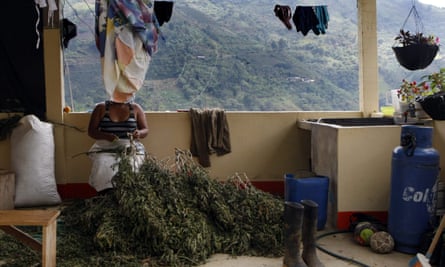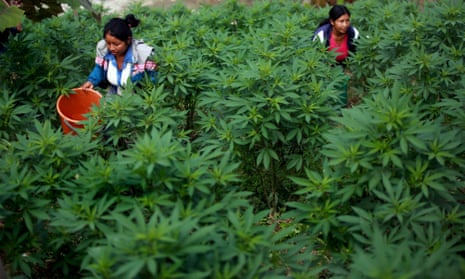When night falls on this south-central Colombian town, the hills above light up like a Christmas tree. Clusters of white lights glow in the darkness, marking the crops that have made Corinto synonymous with Colombian marijuana.
Half of all Colombia’s cannabis production is concentrated in the northern part of Cauca province, and 50% of that is grown in Corinto alone. Police estimate 100 hectares of land in the municipality are dedicated to growing weed; local farmers reckon the real number could be twice that.
So when Colombia recently legalised marijuana for medical and scientific purposes, farmers in Corinto figured they had a corner on the cultivation market.
A group of farmers came together in July to create Caucannabis, a cooperative that aims to be a prime supplier to companies hoping to cash in on Colombia’s new legal marijuana business.
“In this region we have been deeply affected by illegal drugs and terrorism. This is an opportunity for us to make a change,” says cooperative leader Héctor Fabio Sánchez, one of 52 members of the cooperative, most of whom have or have had marijuana crops.
Betania Rodríguez, a cooperative member who asked that her real name not be used, says that marijuana and coca – the raw material for cocaine – are just about the only options for farmers to make a living in this isolated area. Her husband tends the bushes next to their home made of thick bamboo and wooden planks, while she works as a day labourer for other growers trimming the buds to prepare them for sale.
“It’s illegal but it’s all we’ve got,” she says, wiping the sticky resin the buds leave on her hands with a cloth dipped in alcohol.
Since late June, the government has issued licences to three companies to process cannabis-based medicinal products that can be used to treat ailments such as cancer, epilepsy and multiple sclerosis.
Through the licences the government hopes to cash in on the new but growing medical marijuana industry. “Colombia could be the winner of this emerging global market,” said Alejandro Gaviria, the health minister who spearheaded efforts to legalise it in Colombia.
But the industry has not kicked off yet. The licences granted so far are solely to extract the oils and resin from the marijuana, not to grow it.
The three companies who have won the licences plan to grow their own marijuana but farmers in Corinto say that for the new industry to have any real impact in the country, traditional marijuana growers should be the suppliers.
“We are the ones who know the most about growing marijuana in Colombia, so we want to be involved,” says Edward García, mayor of Corinto, who encouraged the growers in his municipality and four other nearby towns to form the cannabis cooperative.
The government has yet to grant anyone a licence to grow marijuana legally and Caucannabis wants to be the first. Companies from Canada and Germany have expressed an interest in possibly building an extraction plant in or near Corinto to buy up local production and produce the resin for export.

García says the legal marijuana project is the perfect example of the alternative development programs that form part of the recently finalised peace accord between the government and the Revolutionary Armed Forces of Colombia (Farc), ending more than 50 years of war.
“This fits in perfectly with the historic moment Colombia is living. This project would do away with the illegal economies that have been the fuel of the conflict,” he says.
The Farc, who here and across Colombia financed their war by taxing the drug trade, have promised to help wean Colombian farmers off of illegal drug crops – both marijuana and coca.
“In this case it wouldn’t be about crop substitution but about substituting the use of the crops,” García says.
But growers here may have to substitute marijuana varieties. A variety known as “kripi”, which has led to the boom in Cauca, is valued by recreational users, but its high level of THC – the chemical responsible for psychoactive effects – is a problem for medicinal use, according to Luc Lapointe, director of a Colombian startup called Kannabicol looking to grow legal marijuana in Colombia to meet Canadian import requirements.
The medical marijuana market looks for a product lower in THC and higher in CDB, the chemical responsible for cannabis’s analgesic, anti-inflammatory and anti-anxiety properties, he said. Other varieties of cannabis also have higher yields than the “kripi” bush.
But there is potential to insert these currently illegal growers into the legal marijuana business. “There is a genuine interest to do something with these farmers,” Lapointe says.
Sánchez, the leader of the cooperative, says more than 500 other marijuana farmers from the region have expressed interest in joining the legal pot project but under current regulation no one with a police record can become a legal producer.
“That eliminates a huge number of current growers,” he says, adding that Caucannabis has urged the government to reconsider the restrictions to give illegal growers a chance to come clean.
“We are eager to change the use from illegal recreational marijuana to legal medical,” says Sánchez. “But things need to move quickly. If it takes two years to get going people will just say, ‘Oh, it was all a lie.’”

Comments (…)
Sign in or create your Guardian account to join the discussion